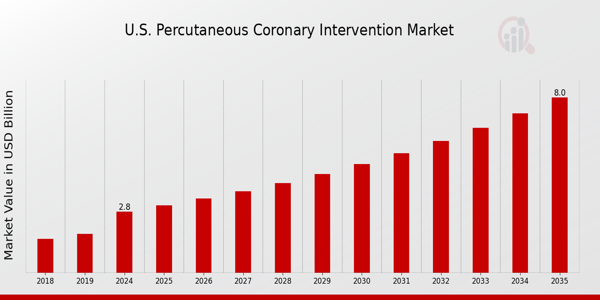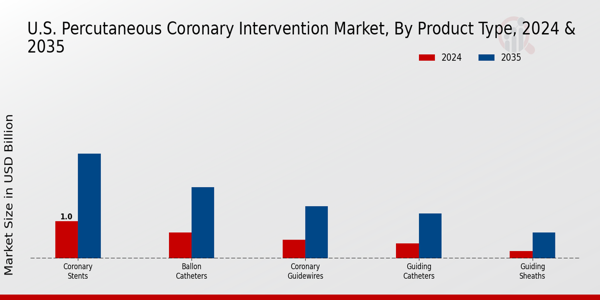US Percutaneous Coronary Intervention Market Overview
As per MRFR analysis, the US Percutaneous Coronary Intervention Market Size was estimated at 2.23 (USD Billion) in 2023.The US Percutaneous Coronary Intervention Market is expected to grow from 2.8(USD Billion) in 2024 to 8.0 (USD Billion) by 2035. The US Percutaneous Coronary Intervention Market CAGR (growth rate) is expected to be around 10.014% during the forecast period (2025 - 2035).
Key US Percutaneous Coronary Intervention Market Trends Highlighted
An aging population and the increasing prevalence of cardiovascular illnesses are two major market drivers driving the US percutaneous coronary intervention (PCI) industry. Effective treatment options are becoming more and more necessary because heart disease is one of the leading causes of death.
Additionally, more effective therapies are being made possible by technological advancements such as drug-eluting stents and enhanced imaging methods.
There are opportunities to develop less invasive procedures and improved recovery protocols, which can result in shorter hospital stays and quicker recovery times for patients. More people are seeking PCI treatments as a result of growing awareness of heart health and preventive measures, which presents opportunities for creative solutions from healthcare providers.
As part of a larger movement toward patient-centric healthcare approaches, there has been a discernible shift in recent years toward outpatient operations and the use of telemedicine for pre-and post-operative care.
Better results are being ensured by the way procedures are carried out and tracked as a result of the use of artificial intelligence and data analytics into healthcare practices.
Furthermore, by accelerating the clearance process for new technology, regulatory backing from organizations such as the Food and Drug Administration has fueled growth. Healthcare facilities throughout the US are investing in professional training and modernizing their surgery suites to handle cutting-edge equipment in response to the growing demand for PCIs.
The market is, therefore, well-positioned for future expansion, with an emphasis on enhancing patient outcomes and meeting the changing demands of the US populace.

Source: Primary Research, Secondary Research, MRFR Database and Analyst Review
US Percutaneous Coronary Intervention Market Drivers
Rising Incidence of Cardiovascular Diseases
The US Percutaneous Coronary Intervention Market is significantly driven by the escalating prevalence of cardiovascular diseases in the United States.
The American Heart Association reported that approximately 697,000 Americans died from heart disease in 2020, accounting for roughly 1 in every five deaths. This alarming statistic highlights the urgent need for effective interventions such as percutaneous coronary intervention, which is performed to alleviate symptoms of coronary artery disease.
As the aging population continues to grow - with projections indicating that by 2030, one in five Americans will be over the age of 65, a group increasingly susceptible to cardiovascular issues - the demand for coronary procedures is expected to rise.
This increasing patient load is further supported by initiatives from the Centers for Disease Control and Prevention, which emphasize prevention strategies and the availability of advanced medical interventions, ensuring that healthcare providers are prepared to meet patient needs.
Technological Advancements in Cardiology
The US Percutaneous Coronary Intervention Market is witnessing substantial growth attributed to rapid technological advancements in cardiology. Innovations such as drug-eluting stents, bioresorbable stents, and improved imaging techniques have enhanced the safety and efficacy of procedures.
According to the FDA, the approval rate of new medical devices in cardiovascular care has steadily increased, with numerous new devices launched every year.
These advancements not only improve patient outcomes but also foster greater confidence among healthcare professionals to adopt PCI procedures, thus expanding market opportunities. Institutions like the American College of Cardiology collaborate to promote training and awareness of these technologies, making them more accessible in everyday clinical practice.
Increase in Healthcare Expenditure
Rising healthcare expenditure in the United States is a critical driver of the US Percutaneous Coronary Intervention Market. According to the Centers for Medicare Medicaid Services, national health expenditure is projected to grow at an average rate of 5.4% per year, reaching approximately $6.2 trillion by 2028.
This increase facilitates greater investments in advanced medical technologies and supports increased access to essential procedures like PCI.
With government initiatives aimed at improving healthcare quality and access, hospitals and clinics are better equipped to invest in necessary technologies, ultimately translating to improved patient care and a higher volume of procedures performed. This broader investment landscape benefits organizations endeavoring to develop and enhance PCI-related technologies.
US Percutaneous Coronary Intervention Market Segment Insights
Percutaneous Coronary Intervention Market Product Type Insights
The US Percutaneous Coronary Intervention Market is characterized by a diverse array of product types that cater to the needs of cardiac procedures. Among these, Coronary Stents hold a prominent position as a crucial component in treating coronary artery disease, providing support to keep arteries open after angioplasty.
Their technological advancement, particularly with drug-eluting stents, has significantly contributed to improved outcomes for patients. Ballon Catheters, essential for angioplasty, facilitate the widening of narrowed or obstructed blood vessels; their role in this field cannot be overstated, as they often represent the first line of treatment for coronary artery diseases.
Guiding Catheters and Coronary Guidewires are pivotal in the navigation and deployment of other instruments during interventions, highlighting the interconnected nature of components in these procedures.
In addition, Guiding Sheaths assist in providing a stable conduit for the introduction of these tools, while Diagnostic Catheters are vital for assessing coronary artery conditions before the procedures take place. The Inclusion of Crossing Catheters allows clinicians to navigate complex vascular structures and achieve optimal access to target locations, thereby enhancing the effectiveness of percutaneous procedures.
Inflation Devices, which aid in the inflation of balloon catheters, play a complementary role in enhancing procedural efficacy, maintaining artery patency, and ensuring the success of interventions. Guidance Systems, utilizing advanced imaging technology, facilitate more precise placements and enhance the safety and efficiency of procedures, contributing to better patient outcomes.
The market also incorporates specialized solutions like Peripheral Thrombectomy Systems and Embolic Protection Systems, addressing complications associated with coronary interventions and improving overall safety during procedures.
Accessories, although sometimes overlooked, play an essential ancillary role, ensuring the smooth operation of all equipment used.
The segmentation of the US Percutaneous Coronary Intervention Market into these various product types reflects the dynamic and multifaceted nature of this industry, driven by a growing population affected by cardiovascular diseases, advancements in technology, and increasing acceptance of minimally invasive procedures by both clinicians and patients alike.
The collective innovations in these product types are transforming the landscape of cardiovascular care in the US, ultimately aiming to enhance procedural success rates and improve long-term patient health outcomes.

Source: Primary Research, Secondary Research, MRFR Database and Analyst Review
Percutaneous Coronary Intervention Market Vascular Access Insights
The Vascular Access segment within the US Percutaneous Coronary Intervention Market plays a crucial role in facilitating various cardiovascular procedures. This segment is vital as it directly impacts the efficiency and safety of accessing the coronary arteries.
Among the techniques used for vascular access, the Radial approach has gained significant traction due to its lower complication rates and faster recovery times compared to traditional methods. Radial access is favored for its ability to reduce patient discomfort and minimize bleeding events, making it increasingly popular among healthcare providers.
Conversely, the Femoral approach remains relevant as it can be advantageous in certain complex cases where large-bore access is necessary. The choice between Radial and Femoral approaches often depends on specific patient characteristics and clinical scenarios, highlighting the importance of personalized medical care.
Furthermore, advancements in technology and training are enhancing the capabilities within this segment, promoting further adoption of less invasive techniques. Overall, the Vascular Access segment is anticipated to continue evolving, driven by the ongoing demand for improved patient outcomes in cardiac procedures within the US healthcare landscape.
Percutaneous Coronary Intervention Market End User Insights
The US Percutaneous Coronary Intervention Market is largely driven by diverse end-user segments, which include Hospitals, Clinics, Ambulatory Surgical Centers, and Others. Hospital clinics play a vital role as they possess advanced equipment and specialized practitioners, making them primary locations for conducting percutaneous coronary interventions.
Additionally, Ambulatory Surgical Centers are gaining traction due to their ability to offer outpatient services, which significantly reduce the overall cost of treatment and enhance patient recovery times. This trend reflects a growing preference for less invasive procedures, aligning with advances in medical technologies.
The "Others" category includes a variety of facilities such as specialized cardiac units and research institutions, which contribute to the broader ecosystem by focusing on innovative treatments and patient management strategies.
As public awareness about heart diseases increases and the population ages, the demand for these facilities and their services is likely to continue rising, contributing to market growth. The dynamics within these End-user segments reflect broader trends in the US healthcare landscape, including a shift towards outpatient care and a focus on cost-effective treatment options.
US Percutaneous Coronary Intervention Market Key Players and Competitive Insights
The US Percutaneous Coronary Intervention Market has witnessed significant growth and competitive dynamics in recent years, influenced by advancements in medical technology, an aging population, and a rising prevalence of cardiovascular diseases.
This market encompasses a variety of products and devices used in minimally invasive procedures to treat coronary artery disease, including stents, balloons, and associated accessories.
The interplay of larger medical device manufacturers and innovative startups has led to an environment rich in research and development, fostering a plethora of treatment options that are more effective and customer-friendly for healthcare providers.
As awareness about heart health increases and the demand for less invasive interventions rises, the competitive landscape continues to evolve, characterized by strategic partnerships, technological advancements, and an emphasis on enhancing patient outcomes.
Terumo Corporation holds a notable position within the US Percutaneous Coronary Intervention Market, leveraging its extensive experience in manufacturing high-quality medical devices. The company’s strengths lie in its innovative product offerings, which include high-performance balloons and stents tailored for various interventional procedures.
Terumo's commitment to research and development has allowed it to introduce state-of-the-art technology that meets the stringent demands of the healthcare sector. The company's strong distribution network ensures optimal market presence across various regions and healthcare settings in the US, contributing to its competitive edge.
Terumo also emphasizes efficient customer support and training programs that aid healthcare professionals in the effective use of their products, further establishing loyalty and trust among practitioners in the cardiovascular domain.
Johnson and Johnson also plays a significant role in the US Percutaneous Coronary Intervention Market, with a portfolio that includes advanced products designed for the treatment of coronary artery disease. Known for its extensive range of coronary stents and catheter options, Johnson and Johnson continues to assert its influence through rigorous research and commitment to innovation.
The company has a strong market presence attributable to its brand reputation and extensive resources that facilitate wide-reaching distribution channels. Johnson and Johnson's strengths can be attributed to its significant investments in mergers and acquisitions, which have enabled the integration of cutting-edge technologies and product lines into their existing offerings.
Furthermore, Johnson and Johnson actively engage in collaborative partnerships with healthcare providers and research institutions, ensuring they remain at the forefront of technological advancements in the medical field, thereby enhancing patient care in the cardiovascular landscape across the US.
Key Companies in the US Percutaneous Coronary Intervention Market Include
- Terumo Corporation
- Johnson and Johnson
- Bard Medical
- Boston Scientific
- Siemens Healthineers
- Schneider Electric
- Philips
- Asahi Intecc
- Angioslide
- Abbott Laboratories
- Medtronic
- MicroPort Scientific Corporation
- Cardinal Health
US Percutaneous Coronary Intervention Market Developments
The US Percutaneous Coronary Intervention (PCI) Market has seen notable developments recently, including significant advancements in catheter technology and enhanced imaging systems. Companies like Boston Scientific and Abbott Laboratories are focusing on innovative drug-eluting stents, while Medtronic is expanding its portfolio of interventional technologies.
In October 2023, Terumo Corporation announced the launch of a new guidewire designed to improve navigation during PCI procedures. Additionally, in September 2023, Johnson Johnson acquired a niche medical device company specializing in thrombectomy devices to strengthen its cardiac care solutions. Boston Scientific has also been actively involved in partnerships aimed at enhancing procedural efficiency.
The market valuation for PCI in the US is growing due to the increasing prevalence of cardiovascular diseases, heightened awareness of preventive care, and advancements in minimally invasive techniques. Significant industry trends indicate that patient outcomes are improving thanks to the integration of advanced technologies, thus contributing to a more dynamic and competitive landscape.
Recent years have also witnessed a rise in collaborations and joint ventures among key players, positioning the US PCI market as a crucial sector in addressing cardiovascular health outcomes effectively.
US Percutaneous Coronary Intervention Market Segmentation Insights
US Percutaneous Coronary Intervention Market Product Type Outlook
- Coronary Stents
- Ballon Catheters
- Coronary Guidewires
- Guiding Catheters
- Guiding Sheaths
- Diagnostic Catheters
- Crossing Catheters
- Inflation Device
- Guidance System
- Peripheral Thrombectomy System
- Embolic Protection System
- Accessories
US Percutaneous Coronary Intervention Market Vascular Access Outlook
US Percutaneous Coronary Intervention Market End User Outlook
- Hospitals Clinics
- Ambulatory Surgical Centers
- Others
| Report Attribute/Metric Source: |
Details |
| MARKET SIZE 2023 |
2.23(USD Billion) |
| MARKET SIZE 2024 |
2.8(USD Billion) |
| MARKET SIZE 2035 |
8.0(USD Billion) |
| COMPOUND ANNUAL GROWTH RATE (CAGR) |
10.014% (2025 - 2035) |
| REPORT COVERAGE |
Revenue Forecast, Competitive Landscape, Growth Factors, and Trends |
| BASE YEAR |
2024 |
| MARKET FORECAST PERIOD |
2025 - 2035 |
| HISTORICAL DATA |
2019 - 2024 |
| MARKET FORECAST UNITS |
USD Billion |
| KEY COMPANIES PROFILED |
Terumo Corporation, Johnson and Johnson, Bard Medical, Boston Scientific, Siemens Healthineers, Schneider Electric, Philips, Asahi Intecc, Angioslide, Abbott Laboratories, Medtronic, MicroPort Scientific Corporation, Cardinal Health |
| SEGMENTS COVERED |
Product Type, Vascular Access, End User |
| KEY MARKET OPPORTUNITIES |
Technological advancements in stent design, Rising demand for minimally invasive procedures, Increase in cardiovascular disease prevalence, Growing geriatric population, Expanding reimbursement policies and support |
| KEY MARKET DYNAMICS |
Aging population, Increasing prevalence of cardiovascular diseases, Technological advancements in stents, Growing demand for minimally invasive procedures, Rising healthcare expenditure |
| COUNTRIES COVERED |
US |
Frequently Asked Questions (FAQ) :
The expected market size of the US Percutaneous Coronary Intervention Market in 2024 is valued at 2.8 USD Billion.
By 2035, the US Percutaneous Coronary Intervention Market is projected to reach a value of 8.0 USD Billion.
The expected CAGR for the US Percutaneous Coronary Intervention Market from 2025 to 2035 is 10.014%.
In 2024, the product type with the highest value in the US Percutaneous Coronary Intervention Market is Coronary Stents, valued at 1.0 USD Billion.
Balloon Catheters are expected to be valued at 0.7 USD Billion in 2024 and 1.9 USD Billion by 2035.
Key players in the US Percutaneous Coronary Intervention Market include Terumo Corporation, Johnson and Johnson, and Boston Scientific.
The projected market value for Coronary Guidewires in 2035 is 1.4 USD Billion.
Growth opportunities in the US Percutaneous Coronary Intervention Market involve advancements in medical technology and increasing prevalence of coronary artery diseases.
The expected market value for Guiding Catheters in 2024 is 0.4 USD Billion.
Factors driving the growth of the US Percutaneous Coronary Intervention Market include technological advancements and an increasing aging population prone to cardiovascular diseases.
The US Percutaneous Coronary Intervention Market is expected to be valued at 2.5 USD Billion in 2024.
By 2035, the US Percutaneous Coronary Intervention Market is projected to reach a value of 7.5 USD Billion.
The expected CAGR for the US Percutaneous Coronary Intervention Market from 2025 to 2035 is 10.503%.
Coronary Stents are expected to hold the largest market share valued at 0.75 USD Billion in 2024.
The market size for Balloon Catheters is projected to be 1.8 USD Billion in 2035.
Major players in the US Percutaneous Coronary Intervention Market include B. Braun, Medtronic, and Boston Scientific.
Growth opportunities for the market are driven by increasing cardiovascular diseases and technological advancements.
Guiding Sheaths are valued at 0.35 USD Billion in 2024, projected to increase to 1.05 USD Billion by 2035.
The growth rate can vary significantly, with Coronary Stents generally leading in market growth.
Key challenges include regulatory complexities and competition from emerging technologies in cardiac interventions.
















